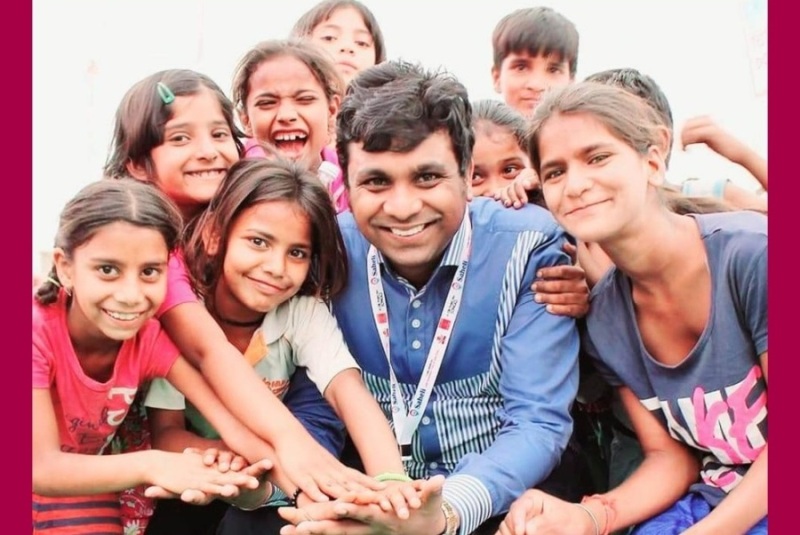Women’s sexual and reproductive health is one of the most ignored health areas Indian families. Despite the advancement in the field of technology, economy and science, we are still plagued by a retrogressive attitude towards women’s sexual and reproductive health, and menstruation in particular. In our country, menstruation still remains a taboo which is not discussed publicly.
In this interview with TheCSRUniverse, Pratibha Pandey, Senior Health Specialist, ChildFund India, speaks on the challenges regarding women’s sexual and reproductive health in India and the measures that can address these challenges and raise public awareness on the issue. She also shares insights on the work done by Child Fund India in these areas. Scroll down to read more.
Q: What are the main areas of concern when it comes to raising awareness about sexual and reproductive health of women? Please shed some light through data points.
A: Violations of women’s sexual and reproductive health and rights are often due to deeply engrained beliefs and societal values pertaining to women’s sexuality. The concept of patriarchy that the role of women is based on the ability to reproduce, early marriage and pregnancies, repeated pregnancies due to preference for sons—has a devastating impact on women’s health with sometimes fatal consequences. Women are also often blamed for infertility and are subjected to various human rights violations as a result. Taboos and stigma surround menstruation - which act as a barrier in letting the required information, reach the community. Only 36% of adolescent girls and women know what menstrual hygiene means and merely 26% use sanitary napkins. According to a report by World Bank, released in 2021, approximately 500 million women and girls globally lack appropriate facilities for menstrual hygiene management.
Q: What are the most degrading taboos and culturally detrimental practices around menstruation? How can they be addressed?
A: Menstruation is still considered impure in many rural areas. Women are subjected to restrictions in their daily lives during their menstruation. Cultural norms and religious taboos on menstruation are often compounded by traditional associations with evil spirits, shame and embarrassment surrounding sexual reproduction. However, this can be addressed by creating awareness around proper management of menstrual hygiene and mobilizing communities, addressing taboos and culturally harmful practices around menstruation. Training mothers on menstrual hygiene management will create peer leaders from the community members, working with adolescent girls by taking the most suitable approach. From our experiences, we have seen that educating the peers, is a good strategy of making the right knowledge reach the girls. They tend to be more comfortable with their peers, so involving both girls and boys would be of help. It is also as important to teach families what menstruation is and that there is nothing to hide or stigmatize about it. Interacting with mothers and fathers helps address the intergenerational gap - because many of the myths and much of the wrong information is passed down from the previous generations.
Q: What is the process of evaluating and reviewing the value chain? What are the steps taken to ensure last mile delivery of services?
A: A woman starts menstruating from the age of 11, approximately till the age of around 50 until menopause, which means that there are about 459 cycles during her lifetime. With how urbanization has taken over, the use of disposable sanitary napkins have also increased. According to a study by Menstrual Hygiene Alliance of India, 336 million women in India use about 1 billion sanitary napkins per month; however, there is no proper disposal mechanism.
In shared and public facilities one must ensure that there is effective disposal mechanism, in addition to proper maintenance of hygiene. In India, there are various taboos attached around menstruation which also causes poor waste management of the hygiene materials. Additionally, another reason for poor waste disposal maybe the lack of clarity around how menstrual waste is classified (solid, hazardous or bio-medical). A menstrual hygiene friendly infrastructure includes clear mechanisms for collecting and disposing the menstrual waste. Menstrual hygiene management (MHM) must be considered to be included in the WASH sector planning. This will ensure that we reach our goals to achieve safety, dignity for women and girls by responding to their biological needs
Better MHM is important for sanitation access, and for gender equity. Improved access to culturally acceptable MHM in sanitation facilities enables women and girls to fully engage in education and at the workforce. Furthermore, toilet facilities must be designed to accommodate menstrual hygiene practices, provide access to absorbents, and encourage safe handling and disposal of used absorbents are important measures supporting women’s health and dignity. In the design of communal toilets, disposal of menstrual waste has often been overlooked, leading to improper waste disposal.
Q: Various female hygiene product manufacturers are now promoting the use of menstrual cups over sanitary pads owing to environmental factors and also affordability. What are your thoughts on this especially in terms of acceptance level and hesitancy? How can social sector stakeholders like NGOs and corporates help change mindsets about the use of menstrual cups?
A: The most apparent advantage of shifting from using sanitary napkins to menstrual cups is that a woman then does not have to replace a napkin very frequently, therefore reducing the number of usage of a public toilet. Moreover, using menstrual cups is sustainable as it reduces waste keeping in mind that there is little knowledge about effective menstrual waste disposal.
A lot of women in urban areas have switched to using menstrual cups. However, its usage is not common due to certain taboos attached to it about virginity of a woman. Therefore, stakeholders must come together to address the myths and generate awareness around effective menstrual hygiene management practices. As a part of the Menstrual Hygiene Scheme, state governments can provide free cups to adolescent girls in addition to training them on its use and benefits.
Q: What’s the Menstrual Hygiene Scheme? How is it beneficial in promoting awareness regarding menstruation amongst students? What are the shortcomings of the same and how can they be managed?
A: The Ministry of Health and Family Welfare introduced a scheme for promotion of menstrual hygiene among adolescent girls in the age group of 10-19 year in rural areas in the year 2011. It was initially implemented in 107 districts in 17 states. Since 2014, the rates for sanitary napkins were subsidized for adolescent girls in rural India. The ASHA workers are currently responsible for ensuring effective distribution of the sanitary napkins. However, civil society organisations who have the reach to the ASHA workers should train them in more appropriate practices. Furthermore, they should conduct regular meetings at aanganwadi centers or any other areas where they sensitize adolescent girls on menstrual hygiene. Additionally, this can also serve as a platform to discuss sexual health and reproductive rights. IEC materials, such as audios, videos and reading material also serve as a good way to communicate the right messaging to the community members.
Q: What is the current situation of ‘Gender Based Violence’ in India? How can this be dealt with to address the problem?
A: According to the National Commission for Women (NCW) in India, the organisation received over 30,000 complaints related to violence and crimes against women in 2022, which is the highest since 2014. As per the NCW, most of these complaints were related to emotional abuse and domestic violence. The outcome of gender-based violence in India is long-lasting for its victims. Hence, it is crucial to address the issue. There is a need for a holistic response model to deal with the issue of gender-based violence. Health professionals, media, and community must combine their efforts to effectively deal with the issue of gender-based violence. Moreover, continuous and rigorous efforts are required to end the stigma associated with gender-based violence in India through awareness generation and by reiterating on how one should response to the same.
Q: With context to the violations of women’s sexual and reproductive health, what is the current scenario of the same in India? Where are the areas we lack and how can we overcome the issue?
A: According to the National Crime Records Bureau, of the six million crimes that police in India recorded between 1 January and 31 December last year, 428,278 cases involved crimes against women. Poor women, especially in developing countries like India, suffer disproportionately from unintended pregnancies, maternal death and disability, sexually transmitted infections including HIV, gender based violence and other problems related to their reproductive system and sexual behaviour. Basis is National Family Health Survey over 21% pregnancies in India are either unwanted or mistimed. The government has introduced practices such as introduction to sex education which aims to create awareness among adolescents about safe sexual practices, implementation of the ‘National Adolescent Education Program’ at various schools from classes 9th to 12th, educating the marriageable age group all about infertility, birth control methods, pregnancy, post-childbirth care of the baby and mother, as well as legal ban been put on Amniocentesis Test by the government.
Q: How are you spreading awareness regarding sexual and reproductive health, especially to women in rural India, and especially regarding their rights to the availability and accessibility of the same?
A: Access to sanitary napkins has certainly increased. More women and girls know about it now and are able to challenge the stigma associated with menstruation. But this is still only a small segment of the population. A decade back when I was visiting villages, I found women using ash, lead and dirty clothes in place of hygienic materials. Now many of them have shifted to clean clothes, but the taboos are still there. They are still segregated and treated unfairly. The general level of awareness is still miniscule. ChildFund India’s adolescent reproductive and sexual health program – GARIMA, which means dignity, works towards empowering youngsters of 11–19 years for their better sexual and reproductive health. Poor knowledge, lack of information, absence of proper guidance, parents’ ignorance, and insufficient healthcare services play a dominant role in adolescents’ poor health. For this, we have been working in collaboration with healthcare professionals, schools, communities, families, government agencies, and local partners.
Q: How is the corporate sector helping you and what kind of CSR interventions can speed up efforts in this domain?
A: There are three things we need to do to achieve effective menstrual hygiene in India:
- Increase awareness among adolescent girls
- Increase access and use of high quality sanitary napkins in rural areas
- Ensure safe disposal of sanitary napkins in an environment friendly manner
While at ChildFund India, we have a program, Garima which provides education on sexual health for adolescents. We also have counselling centers to address issues around menstruation and sexual health. The program is present in 11 states of India at present and this has been possible through our partners across sectors such as government, community members and corporates. However, more awareness needs to be generated around disposal and usage of sanitary napkins and more areas can be covered. Therefore, with more help from additional partners from corporates as a part of their CSR interventions we will be able to continue bringing change effectively.














.jpg)




